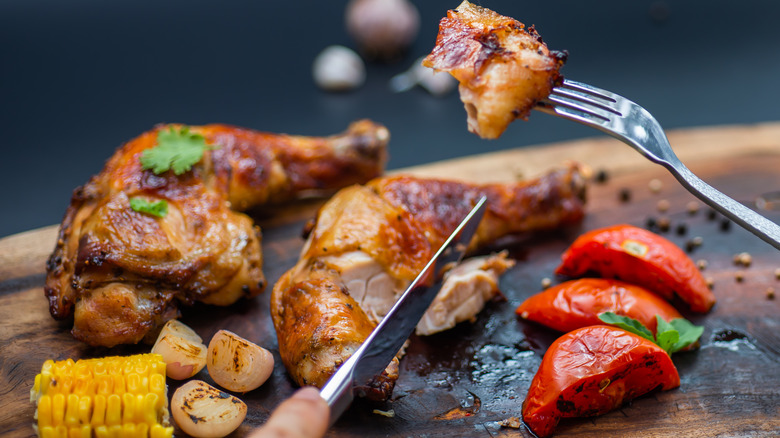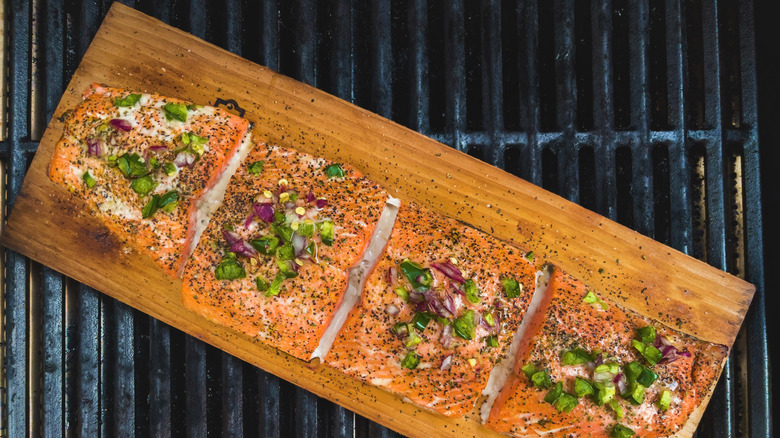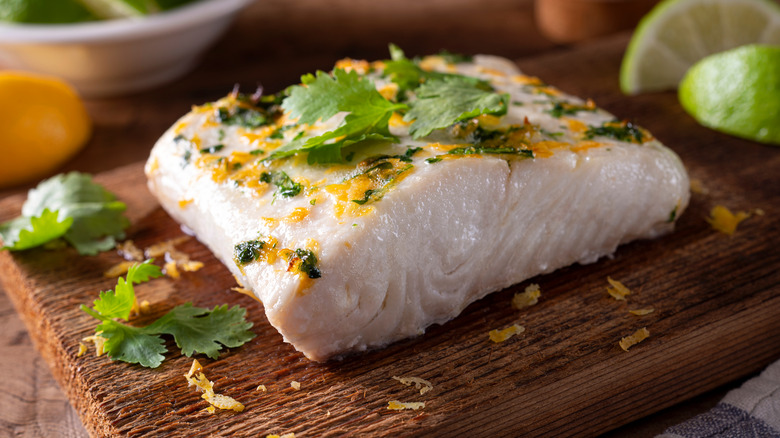How To Smoke Meat On A Plank If You Don't Have A Smoker Handy
If you don't have a smoker but still crave wood-fired flavor, there are many ways to achieve it. While turning your gas grill into a smoker requires tools and equipment like a smoker box and wood chips, you can get the same great smoky flavor without the need for a separate outdoor appliance by using wooden planks.
Wooden planks for grilling, usually cedar, cherry, maple, or hickory, will gently smolder when placed on a grill, imparting a subtle smoky flavor to whatever is cooking on top of it. The wood will protect more delicate foods from the high heat of a grill, which can sometimes reach upwards of 600 degrees Fahrenheit. Planks are also easy to use and don't need a lot of preparation — just a bit of forethought and time. To prevent the wood from catching fire, soaking your planks is a must. You cannot skip this step. You can soak them in water, but why not try beer or wine for some complementary flavors? Soak for at least a half hour before grilling to allow for ample saturation.
Grilling on a plank is great for indirect heat. Pile your charcoal to one side, or leave the burners off on one side of a gas grill. Set up the planks over the heat to singe the wood, then move them to the cooler side. Once the meat goes down on the planks, you'll want to avoid lifting the lid, so cook things like burgers or chicken breasts last.
Grill planks have a limited number of uses
When you're grilling with a plank, make sure you're buying ones that are food-safe and untreated. This means you can't show up at your local Home Depot, grab a slab of cedar, and cook with it, as it will likely have been treated with chemicals like arsenic and copper, which you don't want in your food. You can find grilling planks at the grocery store or a grilling and barbecuing wholesaler. Your plank should be at least ½-inch thick and big enough to leave an inch of wood around the food. You'll want to have a spray bottle of water on hand, plus long tongs and heat-proof gloves while you grill in case of flare-ups and emergencies.
You can reuse planks, depending on how charred they got the first time around, but at most, they can be reused two or three times. However, the flavor won't be as strong as the first use. After the plank has cooled, wash it in water with a gentle sponge and a bit of sandpaper for any stuck-on bits of food. Don't use soap, though, as you'll be able to taste it the next time you use it since wood is porous. If the edges are charred enough to crumble, break it up into chunks and toss it into the charcoal the next time you grill or have a bonfire.
What can you smoke on a grill plank?
When grilling with a plank, you can keep the same food and wood pairings in mind as when using a regular smoker — the more delicate a food, the less intense your plank choice should be. So save those alder planks for delicate whole trout instead of a hearty ribeye or sirloin.
If you're going to experiment with smoking meat like chicken or pork, you can find some planks from fruit trees like apple, cherry, and peach, which will give the finished meat a slightly sweet, fruity flavor. Maple and pecan are also ideal for chicken and pork on the grill. Use hickory and oak for their intense flavors that go well with game meats like bison, deer, beef, or lamb.
You can smoke almost anything on a plank, even cheese. Vegetables, tofu, pork, and soft, rinded cheeses like brie or camembert pair well with cedar because of its subtle spice; even maple would be an ideal pairing.


